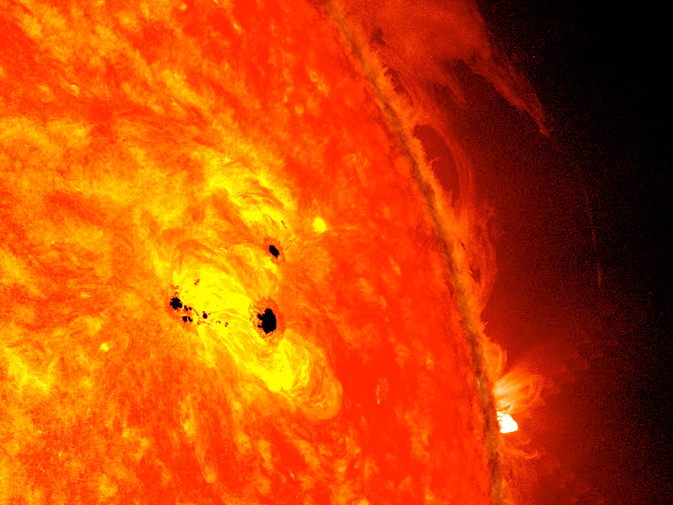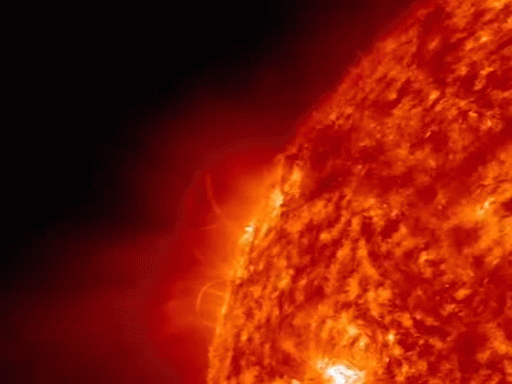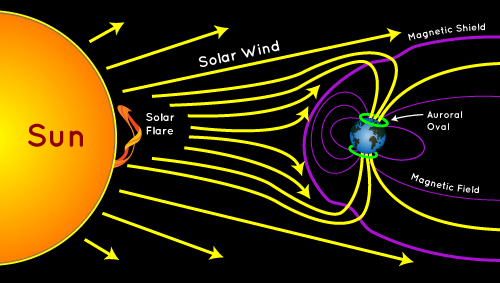Solar Storms | 27 May 2024
Recent studies have found that the Sun's magnetic field originates approximately 32,000 kilometres beneath the sun's surface, which is shallower than previous estimates of over 209,000 kilometres.
- This discovery could help in predicting solar cycles and forecasting occurrences of severe solar storms more accurately.
What are Solar Cycle, Sunspots and Solar Flares?
- Solar Cycle:
- The solar cycle is the cycle that the Sun’s magnetic field goes through approximately every 11 years, during which the it's magnetic activity increases and decreases.
- The Sun, a massive ball of hot, electrically-charged gas, generates a powerful magnetic field that undergoes a cycle known as the solar cycle.
- Every 11 years or so, the Sun's magnetic field completely flips. This means that the Sun's north and south poles switch places.
- The solar cycle affects activity on the surface of the Sun, such as sunspots which are caused by the Sun's magnetic fields.
- The solar cycle is tracked by counting sunspots. It starts with a solar minimum, marked by few sunspots, and progresses to a solar maximum, when sunspot numbers peak.
- The solar cycle is the cycle that the Sun’s magnetic field goes through approximately every 11 years, during which the it's magnetic activity increases and decreases.
- Sunspots:
- Sunspots appear dark on the Sun's surface because they are cooler areas with exceptionally strong magnetic fields, which prevent some heat from reaching the surface.
- Solar Flares:
- The magnetic field lines near sunspots often tangle, cross, and reorganise. This can cause an explosion of energy called a solar flare.
- Solar flares emit significant radiation into space. Intense solar flares can disrupt radio communications on Earth.
- Solar flares are sometimes accompanied by a coronal mass ejection (CME). CMEs are huge bubbles of radiation and particles from the Sun. They explode into space at very high speed when the Sun’s magnetic field lines suddenly reorganise.
What are Solar Storms?
- About:
- Solar storms (geomagnetic storms) occur when a large-scale magnetic eruption, often causing a coronal mass ejection (CME) and associated solar flare, accelerates charged particles in the solar atmosphere to very high velocities.
- Movement Towards Earth:
- These move toward the Earth at a speed of about three million miles per hour.
- When a CME (high-speed solar stream) reaches Earth, it interacts with the magnetosphere which causes the magnetosphere to become compressed and agitated, allowing energetic solar wind particles to reach our atmosphere over the poles.
- The Earth’s magnetosphere is created by its magnetic fields and it usually protects us from the particles emitted by the Sun.
- Impacts of Solar Radiation Storms near Earth:
- When energetic protons collide with satellites or humans in space, they can penetrate deep into the object that they collide with and cause damage to electronic circuits or biological DNA.
- During the more extreme Solar Radiation Storms, passengers and crew in high flying aircraft at high latitudes may be exposed to radiation risk.
- Geomagnetic storms can also cause auroras (northern and southern lights).
Read more: Sunspots, Solar Flare
UPSC Civil Services Examination, Previous Year Question (PYQ)
Q. If a major solar storm (solar flare) reaches the Earth, which of the following are the possible effects on the Earth?(2022)
- GPS and navigation systems could fail.
- Tsunamis could occur at equatorial regions.
- Power grids could be damaged.
- Intense auroras could occur over much of the Earth.
- Forest fires could take place over much of the planet.
- Orbits of the satellites could be disturbed.
- Shortwave radio communication of the aircraft flying over polar regions could be interrupted.
Select the correct answer using the code given below:
(a) 1, 2, 4 and 5 only
(b) 2, 3, 5, 6 and 7 only
(c) 1, 3, 4, 6 and 7 only
(d) 1, 2, 3, 4, 5, 6 and 7
Ans: (c)



